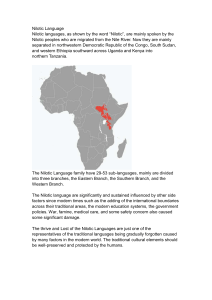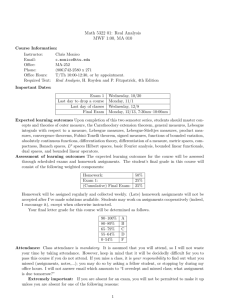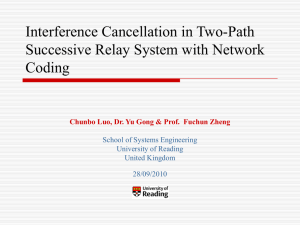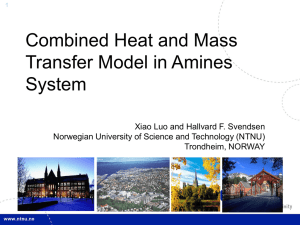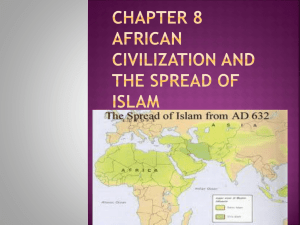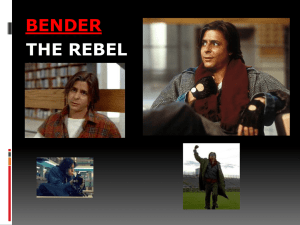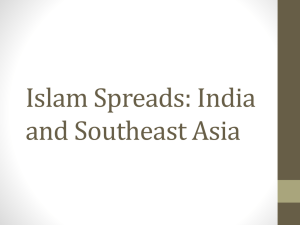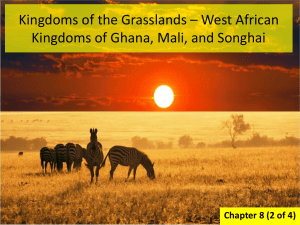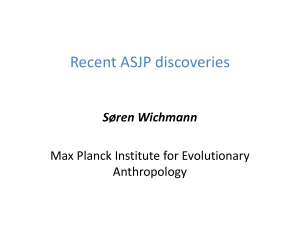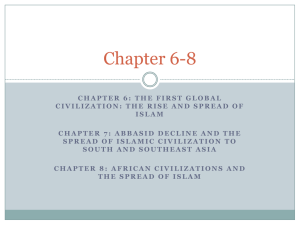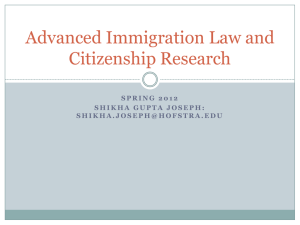Nilo-Saharan Languages
advertisement
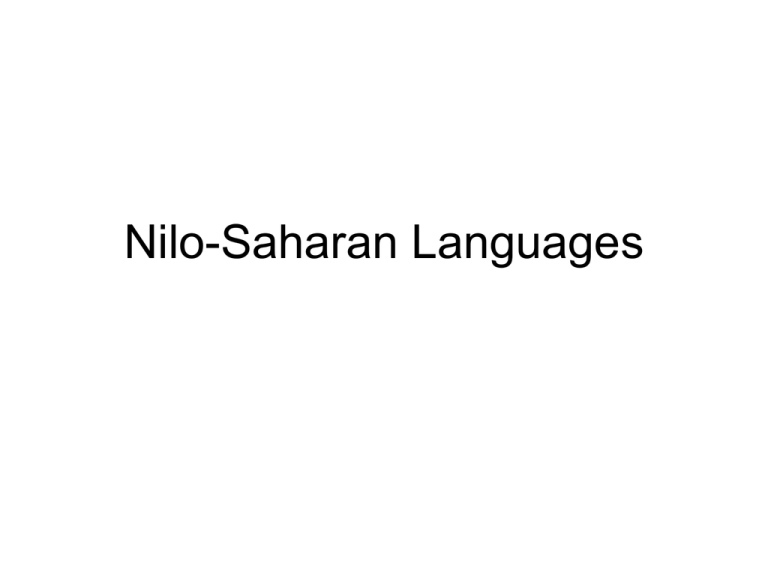
Nilo-Saharan Languages Ehret and Bender: two different views • Reconstruct the family through different methods, and come to different conclusions • Both have positive and negative aspects to their work, but both still appear plausible theories • Both use large lexical bases and pay strong attention to detail Methodological Differences • Bender • Limited use of morphology in reconstruction • Proposes reconstructed phonology based on averaging of sounds across languages • Uses large amounts of sources • Ehret • Reconstructs a variety of proto-forms • Proposes extremely complex proto-phonology • Restricts use of sources, often has only one language source for a whole language family • Bender • More conservative on etymology • Compares words based on similarity in meaning and sound • Does not focus as much on established correspondences • Areal forms excluded • Ehret • Possibly overimaginative etymologies • Extremely attentive to phonetic detail • Places high importance on established sound correspondences and proto-phonology • Does not concern with areal forms Bender’s organization of NS Nilo-Saharan Songay Saharan Kuliak S-C (Satellite-Core) Satellites Maba For (Fur) Central Berta Kunama Sudanic Core East Koman Gumuz Kado Sudanic Ehret’s Organization of NS Nilo-Saharan Sudanic Koman (Includes Gumuz) Central Sudanic Northern Sudanic Kunama Saharo-Sahelian Sahelian Saharan For Ennedian Bodelian Zaghawa Berti Songay Tibu Kanuri Western Sahelian Nara Maban Maba Runga Trans-Sahel Mimi Nubian Eastern Sahelian Western Astaboran Tamam KirAbbaian* Rub Ik Western Rub Kir-Abbaian Jebel West Jebel Gaam Kir Bertha Cental Jebel Western Nilotic Jii Luo Burun JyangNaath Nuba Mts. Daju SurmaNilotic Temein, Nyimang, Jirru Dinik Surmic Eastern Nilotic Bari Southern Nilotic Tung’a Ateker Tato Lutokuo-Maa Lotuko Nilotic Datoga MaaOngamo Kalenjin Omotik Conclusions of comparison? • There is almost nothing in common! • They use many different names for subfamilies, and organize the trees in drastically different ways The sub families (as per Bender) Songai (Songay, Songhai) – : North and South variants, with 6 and 4 dialects each – Spoken in Mali and Niger – Northern variants hybridized with Berber, Hausa, or Fulani Saharan • Kanuri-Kanembu (Borno): Mutually intelligible varieties • Teda: Dialect cluster consisting of North (Teda or Tuda) and South (Daza and Tubu). No single self name • Zagawa-†Berti: Northern Zagawa (Zaghawa) known as Bideyat). Maba(n) • • • • Bora-Mabang (Maba) Masalit Aiki=Runga-Kibet Mimi of Gaudefroy-Demombynes (Mimi GD) • Mimi of Nachtigal (= Mimi N) For(an) • For (Fur): Spoken in Darfur (country of the Fur) in Sudan • Amdang: Spoken in Enclaves in Wadai, Chad border with Sudan, and into Darfur. Berta • Berta: dialect cluster in middle EthioSudan border Area Kunama • Single language spoken in Southern Eritrea Koman • • • • • Twama (= Uduk) Komo Opo-Shita Kwama †Gule Gumuz • No single self-name. Spoken in EthioSudan border area Kuliak • • • • Nyangi: possibly extinct Ik Soo All spoken in Uganda Kado • Mudo-Yegang-Kufo • Miri-Talla-Tolibi_Sangali • Krongo-Talsa East Sudanic • Sub families Nubian, Surmic, Nera, Jebel, Nyima, Tama, Nilotic (Western, Eastern, and Southern) Nubian • • • • • Nobiin Middob Birgid Kenzi-Dongola Hill Nubian: eight dialect with many names Surmic • • • • • • • Majang Murle-Omo Murle-Didinga-Longarim Bale-Zilmanu-Olam Mursi Me’en Kwegu-Muguji Shabo (?) Nera • Single language, also known as Barya or Barea Jebel • • • • Gaam Aka Kelo-Beni-Sheko Molo Nyima • Nyimang • Dinik Temein • Ronge (Temein) • Doni (= Jirru)-Dese(=Teis or Tesei) Tama • Tama • Erenga-Sungor • Merarit Daju • Limited knowledge • East: Shatt, Liguri • West: Nyala-Lagowa, Nyolge, Mongo-Sila, and †Beygo Nilotic:Western Nilotic – Northwest Nilotic: Burun, Mebaan – Northern Luo • Colo, Anywa(Anuak, Anyuak), Jur Luo, Turi, Bor – Southern Luo • Acoli, Kumam, Adola, Luo (Kenya Luo) – Dinka-Nuer • Jieng (=Dinka), Naadh (=Nuer), Atuot Eastern Nilotic • Bari • Teso-Turkana-Lotuko-Maa – Lotuko-Maa: Lotuko, Maa (Masai, Maasai), Ongamo (Ngasa) – Teso-Turkana: Toposa, Turkana, Teso, Karamojong South Nilotic • Omotik-Datooga: Omotik, Datooga • Kalenjin: 4 dialect clusters • Meroitic? Central Sudanic • Extremely fragmented, wide distribution, and lack of data make organization of this difficult • Subfamilies Sara-Bagirmi, Bongo, ModoBaka, Moru-Madi, Mangbutu-Efe, Mangbutu-Asua, Kresh, and Badha (Lendu) Sara-Bagirmi • Sara: confusing term applying to many peoples. – Sar, Mbay, Barma (Bagirmi), Kuka, Kenga. – Sara-Ngambay: Ngambay, Doba. – Sara Kaba: Kaba. – Ruto/Vale • • • • Yulu-Binga Fongoro Shemya Fer Bongo • Single language Modo-Baka • B’eli • Baka • Morokodo Moru-Madi • North(Moru): Moru • Central(Avukaya): Avukaya, Logo, Keliko, High Lugbara, Low Lugbara • South (Madi): Madi Mangbutu-Efe • Mangbutu • Ndo • Mamvu-Balese Mangbetu-Asua • Mangbetu (Unknown language group) • Asua: Asua (Aka). Kresh • Kresh • Aja Badha (Lendu) • Badha Conclusions • Two scholars came up with drastically different conclusions on the structure of the family – Sign of difficulties with the historical model? • Much work needs to still be done: entire language families are still missing basic reference grammars
